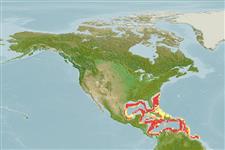Common names from other countries
>
Gadiformes (Cods) >
Macrouridae (Grenadiers or rattails)
Etymology: Coelorinchus: Greek, koilos = a hollow + Greek, rhyngchos = jaw (Ref. 45335).
More on authors: Goode & Bean.
Environment: milieu / climate zone / depth range / distribution range
Ecologia
marinhas batidemersal; não migratória; intervalo de profundidade 400 - 2220 m (Ref. 3587). Deep-water; 34°N - 7°N, 98°W - 52°W (Ref. 1371)
Atlantic: Western Central Atlantic: Florida Straits to northeastern South America. One record from Bermuda. Eastern Atlantic: Faroe Channel to Cape Verde (Ref. 3587); southern Africa.
Tamanho / Peso / Idade
Maturity: Lm ? range ? - ? cm
Max length : 50.0 cm TL macho/indeterminado; (Ref. 1371)
Espinhos dorsais (total) : 2; Espinhos anais: 0. Snout long and sharply pointed, its anterolateral margin almost completely supported by bone; head ridges strong and coarsely spined; the dorsal surfaces of the head completely scaled except for the nasal fossa, scales atop head with spinules set in divergent rows; the underside of the head naked except for small isolated scales above the angle of the mouth and below the end of the opercle ridge in some specimens; swarthy to brownish, ventrally darker on the belly, with no prominent markings; the mouth and gill cavities blackish; the first dorsal fin uniformly dusky (Ref. 1371).
Size may exceed 50 cm TL. Feeds primarily on small fish (myctophids), polychaete worms and crustaceans (pagurids, crabs, shrimps, ostracods, and copepods (Ref. 6187).
Ciclo de vida ou comportamento de acasalamento
Maturities | Reprodução | Spawnings | Egg(s) | Fecundities | Larvas
Cohen, D.M., T. Inada, T. Iwamoto and N. Scialabba, 1990. FAO species catalogue. Vol. 10. Gadiform fishes of the world (Order Gadiformes). An annotated and illustrated catalogue of cods, hakes, grenadiers and other gadiform fishes known to date. FAO Fish. Synop. 125(10). Rome: FAO. 442 p. (Ref. 1371)
Status na Lista Vermelha da UICN (Ref. 130435)
CITES (Ref. 128078)
Not Evaluated
Ameaça para os humanos
Harmless
Uso pelos humanos
Pescarias: pesca de subsistência
Ferramentas
Relatórios especiais
Baixar XML
Fontes da internet
Estimates based on models
Preferred temperature (Ref.
115969): 4.6 - 9.9, mean 5.9 (based on 199 cells).
Índice de diversidade filogenética (Ref.
82804): PD
50 = 0.5000 [Uniqueness, from 0.5 = low to 2.0 = high].
Bayesian length-weight: a=0.00251 (0.00128 - 0.00492), b=3.19 (3.03 - 3.35), in cm Total Length, based on LWR estimates for this Genus-body shape (Ref.
93245).
Nível Trófico (Ref.
69278): 3.6 ±0.48 se; based on food items.
Resiliência (Ref.
120179): Baixo, tempo mínimo de duplicação da população 4,5 - 14 anos (Preliminary K or Fecundity.).
Fishing Vulnerability (Ref.
59153): Moderate vulnerability (40 of 100).
